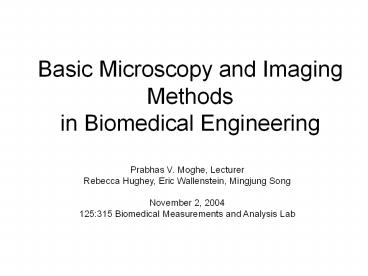Basic Microscopy and Imaging Methods in Biomedical Engineering - PowerPoint PPT Presentation
1 / 20
Title:
Basic Microscopy and Imaging Methods in Biomedical Engineering
Description:
Basic Microscopy and Imaging Methods in Biomedical Engineering Prabhas V. Moghe, Lecturer Rebecca Hughey, Eric Wallenstein, Mingjung Song November 2, 2004 – PowerPoint PPT presentation
Number of Views:186
Avg rating:3.0/5.0
Title: Basic Microscopy and Imaging Methods in Biomedical Engineering
1
Basic Microscopy and Imaging Methods in
Biomedical Engineering
Prabhas V. Moghe, Lecturer Rebecca Hughey, Eric
Wallenstein, Mingjung Song November 2,
2004 125315 Biomedical Measurements and Analysis
Lab
2
WWW Bibliography -- Supplementary Review
Materials
General Resources Primer in Microscopy by
Olympus http//www.olympusmicro.com/primer/optica
lmicroscopy.html Molecular Expressions A
comprehensive resource maintained by Florida
State University. Includes a Microscopy Primer
with tutorials on optical microscopy, digital
imaging http//micro.magnet.fsu.edu/primer/ micr
oscopy.info An information source for
microscopy and microanalysis including a
hyperlinked glossary and links to professional
societies and educational resources.
http//www.mwrn.com World Wide Web Virtual
Library Microscopy http//www.ou.edu/research/el
ectron/www-vl/long.shtml Vast set of links
covering all aspects of light, electron, and
other types of microscopy, including extensive
lists of imaging and microscopy labs, image
galleries, and educational sites. Live Cell
Imaging Applications in Confocal Microscopy A
lecture by Dr. J. Paul Robinson at Purdue
Univ. http//www.cyto.purdue.edu/flowcyt/educate/c
onfocal/524Lec11/sld001.htm NIH Office of
Extramural Research Links to Bioimaging Sites
http//grants2.nih.gov/grants/bioimaging/links.ht
m Standard Microscopy Terminology
http//resolution.umn.edu/glossary/FrameGloss.html
A comprehensive glossary of microscopy terms
made available by the University of Minnesota
Characterization Facility. Microscopy/Imaging
Resources on WWW http//swehsc.pharmacy.arizona.e
du/exppath/micro/index.html A very
well-organized, extensive collection of
educational and informational resources,
including links to numerous online image
galleries, microscopy sites, and an introduction
to digital imaging. Science Magazine, April
2003, Special Issue on Biological Imaging
3
Outline
Physics of Optical Microscopy Bright Field
Microscopy Phase Contrast Microscopy Fluorescenc
e Microscopy Confocal Microscopy Biomedical
Image Processing Image Acquisition Image
Processing Steps Image Analysis Cellular
Properties Derived via Biomedical Imaging
4
Electromagnetic Spectrum
The wavelength required to see an object must
be the same size of smaller than the object
5
Choice of Microscopy Depends on the Scale of
Imaging
6
Principle of Compound Light Microscopy
7
Physics of Optical Microscopy
The ability of a microscope objective to
"grasp" the various rays coming from each
illuminated part of the specimen is related to
the angular aperture of the objective. N.A.
n . sin (u) n refractive index u1/2
subtended angle - Max theoretical N.A. of a dry
objective is 1 - Max theoretical N.A. of oil
immersion objectives is 1.5
8
Optical Microscopy Issues Resolution
Resolution is defined as the ability of an
objective to separate clearly two points or
details lying close together in the specimen.
where Rresolution distance l, the wavelength
of light used N.A. the numerical aperture.
- As N.A. increases, resolution gets better (R
smaller). - Longer wave lengths yield poorer
resolution.
9
Bright and Dark Field Contrast
10
Bright Field vs. Dark Field Microscopy
11
Principle of Phase Contrast Microscopy
Zernicke Greatest advance in Microscopy
(1953) Phase microscopy requires phase
objectives and a phase condensor.
12
Contrast MicroscopyPhase Contrast DIC
13
Fluorescence MicroscopyPrinciple of Fluorescence
14
Fluorescence Microscopy
Dichroic Mirror
Barrier Filter
Exciter Filter
Mercury Light Source
Objective/ Condensor
Specimen
15
Microscopy to Image Cell Structure And Cell
Architecture on Biomaterial Substrates
Use of fluorescence microscopy and
transmitted/reflected imaging
Cytoskeletal Organization
Rounded Phenotype
Mildly Polarized Phenotype
16
Selected Basic Definitions in Biomedical Imaging
Image Analysis
- Pixels 2-D Picture Elements
- Mean Gray Level Gray-scale Intensity (0-256)
- MGL Histogram
- Segmentation and Thresholding (MGL Contrast)
- Filtering
- Densitometry
- Morphometry (Area, Shape factor, Polarity/Aspect
Ratio)
17
Spatial and Gray Level Digital Resolution
- Spatial resolution
- of samples per unit length or area
- DPI dots per inch specifies the size of an
individual pixel - If pixel size is kept constant, the size of an
image will affect spatial resolution
- Gray level resolution
- Number of bits per pixel
- Usually 8 bits
- Color image has 3 image planes to yield 8 x 3
24 bits/pixel - Too few levels may cause false contour
18
Same Size, Different Pixel Sizes
19
Example of Biomedical Image Processing
Biomedical polymer sponges were saturated with
a fluorophore (fluorescein isothiocyanate - FITC)
imaged on a microscope using fluorescence
microscopy. Images of each porous field were
digitized and stored on the computer.
Digitized images were analyzed using biomedical
image processing to identify the number, shape,
and location of pores. (Similar approaches can be
used to identify fluorescently labeled cells and
cell number, cell viability, cell morphology)
Tjia and Moghe, J. Biomed. Mater. Res (Appl
Biomat) 43 291, 1998
20
Outline of the Lab ExercisesMicroscopy and
Cellular Imaging
Learn how to use a computer-interfaced
optical microscope archive images process
images and quantify results identify cells via
fluorescence labeling of the cytoskeleton show
cells are viable via fluorescence labeling of
DNA visualize cell borders quantify cell
morphology (phenotyping)































